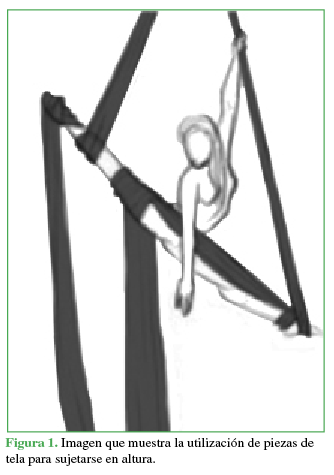Thoracolumbar spine injury associated with aerial skill practice. Case reports
Main Article Content
Abstract
Objective: To learn the nature of the injury, to recognize the injury predisposing factors and the safety measures used, to study the kinematics, to classify the injury, and to analyze the treatment.
Materials and Methods: Six patients were included. The evaluation included individual body structure, drop kinematics, safety measures, classification of fractures according to the new AO classification, neurological symptoms, treatment, and complications.
Results: The study included six female patients, averaging 24 years, a body mass index of 19.29 and a fall from 3.08m, 4 of which included mattress <5cm. The main injuries classification resulted in 6 A1, 4 B2 and 1 C. No neurological deficit was found. Four patients underwent surgical treatment.
Conclusions: Aerial silk is a circus activity that has recently become a worldwide practice. Women are more exposed. Rigorous training and the use of safety elements are necessary to avoid injuries. We did not observe a unique pattern of injury, because of its multifactorial cause. The therapeutic decision-making is related to the spinal injury.
Downloads
Metrics
Article Details
Manuscript acceptance by the Journal implies the simultaneous non-submission to any other journal or publishing house. The RAAOT is under the Licencia Creative Commnos Atribución-NoComercial-Compartir Obras Derivadas Igual 4.0 Internacional (CC-BY-NC.SA 4.0) (http://creativecommons.org/licences/by-nc-sa/4.0/deed.es). Articles can be shared, copied, distributed, modified, altered, transformed into a derivative work, executed and publicly communicated, provided a) the authors and the original publication (Journal, Publisher and URL) are mentioned, b) they are not used for commercial purposes, c) the same terms of the license are maintained.
In the event that the manuscript is approved for its next publication, the authors retain the copyright and will assign to the journal the rights of publication, edition, reproduction, distribution, exhibition and communication at a national and international level in the different databases. data, repositories and portals.
It is hereby stated that the mentioned manuscript has not been published and that it is not being printed in any other national or foreign journal.
The authors hereby accept the necessary modifications, suggested by the reviewers, in order to adapt the manuscript to the style and publication rules of this Journal.
References
2. Wanke EM, McCormack M, Koch F, Wanke A, Groneberg D. Acute injuries in student circus artists with regard to gender specific differences. Asian J Sports Med 2012;3(3):153-60. https://doi.org/10.5812/asjsm.34606
3. Wolfenden HEG, Angioi M. Musculoskeletal injury profile of circus artists. A systematic review of the literature. Med Probl Perform Art 2017;32(1):51-9. https://doi.org/10.21091/mppa.2017.1008
4. Shrier I, Meeuwisse WH, Matheson GO, Wingfield K, Steele RJ, Prince F, et al. Injury patterns and injury rates in the circus arts. An analysis of 5 years of data from Cirque du Soleil. Am J Sports Med 2009;37(6):1143-8. https://doi.org/10.1177/0363546508331138
5. Bazán PL, Borri AE, Feldman D, Szmidt VE. Evaluación cinemática del trauma raquimedular. Presentado en formato Póster Electrónico durante el IX Congreso SILACO – XXI Congreso GEER, Santander, España, 31 de mayo, 1 y 2 de junio de 2007.
6. Bazán PL, Borri AE, Szmidt VE. Lesiones vertebrales y medulares en pacientes que presentaron caídas de altura. Rev Asoc Platense Ortop Traumatol 2006/2009:149-154.
7. Sawyer JR. Fracture patterns in children and young adults who fall from significant heights. J Pediatr Orthop 2000;20(2):197-202. PMID: 10739282
8. Goodacre S, Goyder E, Joseph A. Can the distance fallen predict serious injury after a fall from a height? J Trauma 1999;46(6):1055-8. https://doi.org/10.1097/00005373-199906000-00014
9. Wittenberg R, Hargus S, Reinhard S. Noncontiguous unstable spine fractures. Spine (Phila PA 1976) 2002;27(3):254-7. https://doi.org/10.1097/00007632-200202010-00010
10. Hamilton GM, Meeuwisse WH, Emery CA, Shrier I. Examining the effect of the injury definition on risk factor analysis in circus artists. Scand J Med Sci Sports 2012;22(3):1-5. https://doi.org/10.1111/j.1600-0838.2010.01245.x
11. Vaccaro AR, Oner C, Kepler CK, Dvorak M, Schnake K, Bellabarba C, et al. AOSpine Thoracolumbar Spine Injury Classification System. Fracture description, neurological status, and key modifiers. Spine (Phila Pa 1976) 2013;38(23):2028-37. https://doi.org/10.1097/BRS.0b013e3182a8a381
12. Löber M. Ergebnisse der Untersuchung zur beruflichen Beanspruchungssituation von Artisten: Untersuchungsbericht. Arbeitsmedizinische Informationen für Theater und Orchester 1985;1:18.
13. Loock F, Windisch B, Katzschke N. Rahmenarbeitsplatzcharakteristiken. Arbeitsmedizinische Informationen für Theater und Orchester 1982;1:12.
14. www.cirquedusoleil.com/en/jobs/casting/team/mentor/andre-sinard.aspx
15. Kahle S. Probleme der Arbeitshygiene und Berufskrankheiten bei Artist/innen. En: Bemmann H. Red. (ed). Die Artisten. ihre Arbeit und ihre Kunst. Berlin: Henschel; 1970:213-36.
16. Solomon R, Brown T, Gerbino PG, Micheli LJ. The young dancer. Clin Sports Med 2000;19(4):717-39. https://doi.org/10.1016/s0278-5919(05)70234-9

